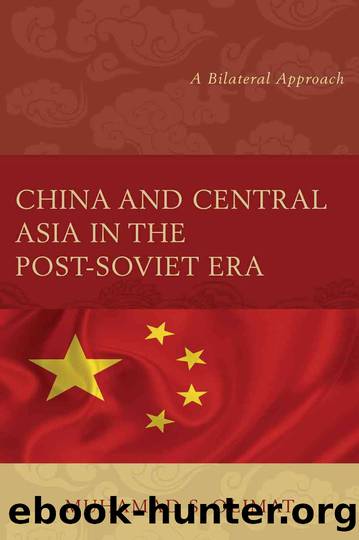China and Central Asia in the Post-Soviet Era by Olimat Muhamad S.;

Author:Olimat, Muhamad S.;
Language: eng
Format: epub
Publisher: Lexington Books
Kazakhstan coordinated with the United States against the Taliban and Al Qaeda. China also cooperated in varying degrees with the United States and deeply influenced Washingtonâs perception of the terrorist threat in Central Asia. However, it demanded that the UN assume the leading role in the âwar on terror.â In exchange for its cooperation, in 2003 Washington designated the ETIM a terrorist organization. As a result, anti-terror operations and coordination tops the Sino-Kazakh agenda.
Beijing is primarily interested in combating East Turkistani separatists. Therefore, it organized ten anti-terror drills through the SCO since June 2001. Most recently, and most notable, on August 24, 2014, it hosted the SCOâs multilateral anti-terror drill, the 2014 âPeace Mission,â in its Inner Mongolia Autonomous Region. The drill was supervised by the deputy chiefs of general staffs of China, Kazakhstan, Kyrgyzstan, and Tajikistan, along with the deputy commander of Russiaâs eastern military command. An estimated that 7,200 troops participated: 5,000 from China and 2,200 from four other SCO countries. âThe drill focused on joint multilateral decision making and action, with exchanges of anti-terror intelligence among the SCO members to effectively boost the troopsâ coordinated ability to fight terrorism . . . aims to deter the âthree evil forcesâ of terrorism, separatism and extremism.â41
Finally, Sino-Kazakh cooperation includes the establishment of a nuclear-free Central Asia. Nevertheless, Beijing supports Astanaâs plan to construct a peaceful nuclear programs to meet its increasing demands for electricity, nuclear medicine, and other related aspects of nuclear energy. China has also introduced renewable energy technology in the areas of solar and wind energy.
Conclusion
Sino-Kazakh relations, which have grown rapidly since 1992, culminated in the 2006 strategic partnership agreement that is based primarily on energy cooperation. Kazakhstan exports 16% (estimated at 220,000 bpd) of its annual oil production to China; this is expected to increase to 400,000 bpd. Their economies are increasingly integrating in a complementary fashion. Chinese corporations are heavily involved in the minerals sector, construction projects, exporting goods and services, consumer goods, telecommunications, aviation technology, agricultural technology, the pharmaceutical industry, and other sectors. Both countries are coordinating closely in responding to regional security threats. Their views on regional and international affairs, which seem to be identical, are characterized by close coordination at the highest levels. Beijing and Astana also emphasize the importance of cultural relations, people-to-people ties, and, most importantly, the revival of the Silk Road spirit and trade in order to integrate the economies of the traditional zone of the Silk Road Economic Belt and Eurasia.
The future of Sino-Kazakh relationship is very promising, for it is grounded in mutual support of each otherâs core issues. However, their bilateral engagement is increasingly tilting in Chinaâs favor due to the latterâs ambitious agenda for exploiting the Kazaksâ large oil, natural gas, and agricultural resources, not to mention its mineral wealth. This trend has generated some anxiety among the countryâs nationalists and Islamists.
Notes
1. China Daily, September 7, 2013. President Xi Proposes Silk Road Economic belt at:http://www.chinadaily.com.cn/china/2013xivisitcenterasia/2013-09/07/content_16951811.htm
2. Kemp, Geoffrey, 2010, The East Moves West: India, China and Asiaâs Growing Presence in the Middle East.
Download
This site does not store any files on its server. We only index and link to content provided by other sites. Please contact the content providers to delete copyright contents if any and email us, we'll remove relevant links or contents immediately.
| Anthropology | Archaeology |
| Philosophy | Politics & Government |
| Social Sciences | Sociology |
| Women's Studies |
The Secret History by Donna Tartt(18790)
The Social Justice Warrior Handbook by Lisa De Pasquale(12103)
Thirteen Reasons Why by Jay Asher(8761)
This Is How You Lose Her by Junot Diaz(6728)
Weapons of Math Destruction by Cathy O'Neil(6102)
Zero to One by Peter Thiel(5652)
Beartown by Fredrik Backman(5566)
The Myth of the Strong Leader by Archie Brown(5390)
The Fire Next Time by James Baldwin(5215)
How Democracies Die by Steven Levitsky & Daniel Ziblatt(5105)
Promise Me, Dad by Joe Biden(5054)
Stone's Rules by Roger Stone(5002)
100 Deadly Skills by Clint Emerson(4816)
A Higher Loyalty: Truth, Lies, and Leadership by James Comey(4813)
Rise and Kill First by Ronen Bergman(4670)
Secrecy World by Jake Bernstein(4611)
The David Icke Guide to the Global Conspiracy (and how to end it) by David Icke(4580)
The Farm by Tom Rob Smith(4412)
The Doomsday Machine by Daniel Ellsberg(4386)
